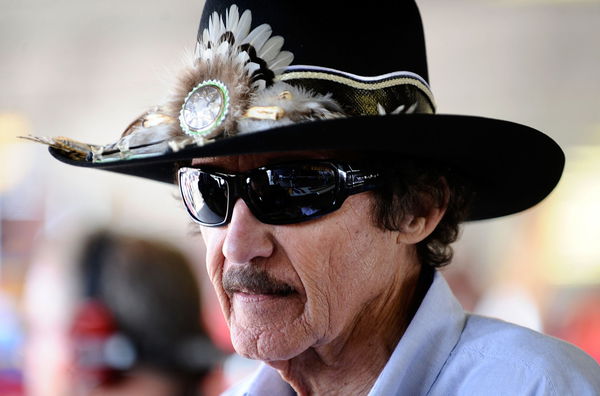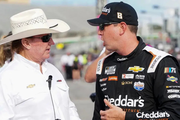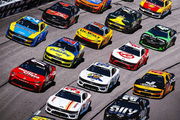
via Getty
WATKINS GLEN, NY – AUGUST 06: Team owner Richard Petty stands in the garage during practice for the NASCAR Heluva Good! Sour Cream Dips at The Glen on August 6, 2010 in Watkins Glen, New York. (Photo by Jeff Zelevansky/Getty Images for NASCAR)

via Getty
WATKINS GLEN, NY – AUGUST 06: Team owner Richard Petty stands in the garage during practice for the NASCAR Heluva Good! Sour Cream Dips at The Glen on August 6, 2010 in Watkins Glen, New York. (Photo by Jeff Zelevansky/Getty Images for NASCAR)
Richard Petty, a legend in his own right, has always had a clear stance in debates about revving up the next-gen cars: crank up the horsepower. This not only amps up the speed but also injects an extra dose of excitement into the race tracks. Take Petty’s 1970 Plymouth Superbird car, for instance. Even half a century ago, these machines were capable of hitting a blistering 200 miles per hour.
However, despite all its cutting-edge features and design, the car didn’t initially catch on in popularity, only coming into the limelight in more recent times. It’s now become a hot favorite among drivers with a passion for speed and power. Rumor has it, the car could fetch north of $250k now, proving that it’s a true ‘ugly duckling to swan’ story. The spotlight really began to shine on the car after Strip “The King” Weathers, a character from the animated hit “Cars,” gained fame. This character, mirroring Petty’s Superbird, sported a light blue hue. Interestingly, it was Richard Petty himself who voiced this character, adding an authentic touch.
ADVERTISEMENT
Article continues below this ad
How the Plymouth Superbird of Richard Petty transformed into a thing of beauty over time
Back in 1970, the Superbird, with Richard Petty at the helm, ruled the NASCAR tracks like few others. Yet, unlike its counterparts, which included Ford Grand Torino, it didn’t charm the public right away. Many of these cars ended up as lot warmers, gathering dust. Fast forward to half a century later, and this car is celebrated as a legendary muscle car, thanks to the “Cars” franchise, with movies in 2006, 2011, and 2017. In these films, Strip “The King” Weathers is depicted as a seven-time Piston Cup champion, a title later equaled by the character Lightning McQueen. The character’s appeal, intertwined with Richard Petty’s real-life 1970s Superbird, transformed the Plymouth model into a sought-after treasure, captivating a broad audience and upgrading its status significantly.
Larry Cate, who owns one of Petty’s Superbirds, believes its fame grew over time, partly thanks to its divisive looks. Initially, it left people scratching their heads, wondering who in their right mind would drive such a beast to the grocery store. It was seen as impractical, to say the least. But as time went on, it gained the recognition it deserved.
Watch This Story: Bubba Wallace’s canine companion steals the show
The car’s inception goes back to 1968 when Ford was outpacing Chrysler’s NASCAR teams. Dodge’s General Manager, Bob McCurry, challenged his team to outdo Ford, no matter what it took. At the time, Chrysler was also dabbling in rocket science, working on Operation Paper Clip with the U.S. government, which meant they had actual rocket scientists to call upon. The result? The Dodge Daytona.
Gary Romberg, a rocket scientist who passed away in February 2020, was the brains behind the Superbird creation. Essentially a Road Runner with a nearly 20-inch nose cone and a colossal wing, it was designed to cut through the air and stay stable. The aim? To entice Richard Petty onto the team. Petty went on to clinch 18 races in the Superbird. But despite its track success, it wasn’t a hit in the showrooms. Rumor has it, that dealers even modified them back into regular Road Runners to get them off the lots.
Under its hood lay a 440 cubic inch V8, pumping out 375 horsepower, with the HEMI version reaching 425 horsepower. Thanks to its aerodynamic design, Petty was one of the few to break the 200-mph barrier in NASCAR.
However, this success was short-lived. In 1971, NASCAR introduced new rules, capping engine displacement for aerodynamically shaped cars like the Superbird at 305 cubic inches, because they were simply too fast. And just like that, the Superbird’s reign ended.
But it’s far from forgotten. Even without Petty’s signature, a Superbird can fetch upwards of a quarter of a million dollars today. The Superbird made a comeback of sorts in 2015, eight years after its heyday, proving that some legends really do have staying power.
Trending
Nearly half a century later, the Superbird made a grand reappearance on the road in 2015
The legendary Plymouth Superbird car, more accustomed to the quiet halls of museums, now resides in the Richard Petty Museum in North Carolina. But, this iconic piece of racing history wasn’t destined to collect dust any longer.
At the 2015 Goodwood Festival of Speed, held from June 25 to 28, a special reunion was set to happen. Racing legend Richard Petty was to be joined by his old comrade, the Superbird. However, the Goodwood crew couldn’t contain their excitement and flew over to the museum to bring this mechanical beast back to life on the road. And who can blame them? The raw sound of the Plymouth alone is music to any car enthusiast’s ears.
ADVERTISEMENT
Article continues below this ad
ADVERTISEMENT
Article continues below this ad
Read More: Take Home a Racing ‘Icon’ for $150 as Richard Petty Announces Exclusive Wine Collaboration
This was the first time in 45 years that the muscle car really got to show what it’s made of, and NASCAR fans got a sneak peek of this historical moment. It was a rare treat to see this old warrior thunder down the road once again, reviving memories and creating new ones.
ADVERTISEMENT
ADVERTISEMENT
ADVERTISEMENT
ADVERTISEMENT






